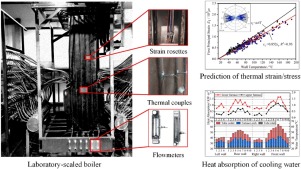当前位置:
X-MOL 学术
›
Process Saf. Environ. Prot.
›
论文详情
Our official English website, www.x-mol.net, welcomes your feedback! (Note: you will need to create a separate account there.)
Experimental study on heat transfer process in boilers to predict thermal strain/stress distribution and deformation risk of membrane walls
Process Safety and Environmental Protection ( IF 7.8 ) Pub Date : 2020-06-01 , DOI: 10.1016/j.psep.2020.03.018 Lian Li , Na Li , Du Wen , Yashu Yao , Qulan Zhou , Yunjin Ao
Process Safety and Environmental Protection ( IF 7.8 ) Pub Date : 2020-06-01 , DOI: 10.1016/j.psep.2020.03.018 Lian Li , Na Li , Du Wen , Yashu Yao , Qulan Zhou , Yunjin Ao

|
Abstract As boilers are designed with higher parameters and larger capacity, deformation failure caused by thermal stress seriously threatens the safety of heating surfaces, especially membrane walls. In this paper, thermal strain/stress distribution on membrane walls, and its relationship with heat transfer process in the furnace were experimentally investigated in a laboratory-scaled arch-fired boiler. Tension strain and compression stress were detected on membrane walls, with definite directionality decided by wall structure. The measured high stress and high temperature zones coincided well with the location of deformation failure in the prototype boiler. Temperature on membrane walls links the heat transfer process and strain/stress distribution. A high level of wall temperature enhanced the directionality of strain/stress, while dispersive temperature gradient weakened such directionality. Additionally, significant correlations were found between wall temperature and corresponding thermal strain/stress. By defining constraint coefficients (β1, β2) and stress coefficients ( k e , k τ ), a model was proposed to quantitatively predict the strain/stress distribution on membrane walls. It provides a way to reduce the deformation risk of membrane walls via improving heat transfer process. Furtherly, the temperature-strain/stress correlations found in the arch-fired boiler were validated in another wall-fired boiler, thus provide great value in safety precaution to various boiler types.
中文翻译:

锅炉传热过程预测膜壁热应变/应力分布及变形风险的实验研究
摘要 由于锅炉设计参数更高、容量更大,热应力引起的变形破坏严重威胁受热面特别是膜式墙的安全。在本文中,膜壁上的热应变/应力分布及其与炉内传热过程的关系在实验室规模的拱形燃烧锅炉中进行了实验研究。在膜壁上检测到拉应变和压应力,其方向性由墙体结构决定。测得的高应力和高温区与原型锅炉变形失效的位置吻合。膜壁上的温度将传热过程和应变/应力分布联系起来。高水平的壁温增强了应变/应力的方向性,而色散温度梯度削弱了这种方向性。此外,还发现壁温与相应的热应变/应力之间存在显着相关性。通过定义约束系数(β1、β2)和应力系数(ke、k τ),提出了一种定量预测膜壁应变/应力分布的模型。它提供了一种通过改进传热过程来降低膜壁变形风险的方法。此外,在拱形燃烧锅炉中发现的温度-应变/应力相关性在另一台壁式燃烧锅炉中得到验证,从而为各种锅炉类型的安全预防提供了重要价值。通过定义约束系数(β1、β2)和应力系数(ke、k τ),提出了一种定量预测膜壁应变/应力分布的模型。它提供了一种通过改进传热过程来降低膜壁变形风险的方法。此外,在拱形燃烧锅炉中发现的温度-应变/应力相关性在另一台壁式燃烧锅炉中得到验证,从而为各种锅炉类型的安全预防提供了重要价值。通过定义约束系数(β1、β2)和应力系数(ke、k τ),提出了一种定量预测膜壁应变/应力分布的模型。它提供了一种通过改进传热过程来降低膜壁变形风险的方法。此外,在拱形燃烧锅炉中发现的温度-应变/应力相关性在另一台壁式燃烧锅炉中得到验证,从而为各种锅炉类型的安全预防提供了重要价值。
更新日期:2020-06-01
中文翻译:

锅炉传热过程预测膜壁热应变/应力分布及变形风险的实验研究
摘要 由于锅炉设计参数更高、容量更大,热应力引起的变形破坏严重威胁受热面特别是膜式墙的安全。在本文中,膜壁上的热应变/应力分布及其与炉内传热过程的关系在实验室规模的拱形燃烧锅炉中进行了实验研究。在膜壁上检测到拉应变和压应力,其方向性由墙体结构决定。测得的高应力和高温区与原型锅炉变形失效的位置吻合。膜壁上的温度将传热过程和应变/应力分布联系起来。高水平的壁温增强了应变/应力的方向性,而色散温度梯度削弱了这种方向性。此外,还发现壁温与相应的热应变/应力之间存在显着相关性。通过定义约束系数(β1、β2)和应力系数(ke、k τ),提出了一种定量预测膜壁应变/应力分布的模型。它提供了一种通过改进传热过程来降低膜壁变形风险的方法。此外,在拱形燃烧锅炉中发现的温度-应变/应力相关性在另一台壁式燃烧锅炉中得到验证,从而为各种锅炉类型的安全预防提供了重要价值。通过定义约束系数(β1、β2)和应力系数(ke、k τ),提出了一种定量预测膜壁应变/应力分布的模型。它提供了一种通过改进传热过程来降低膜壁变形风险的方法。此外,在拱形燃烧锅炉中发现的温度-应变/应力相关性在另一台壁式燃烧锅炉中得到验证,从而为各种锅炉类型的安全预防提供了重要价值。通过定义约束系数(β1、β2)和应力系数(ke、k τ),提出了一种定量预测膜壁应变/应力分布的模型。它提供了一种通过改进传热过程来降低膜壁变形风险的方法。此外,在拱形燃烧锅炉中发现的温度-应变/应力相关性在另一台壁式燃烧锅炉中得到验证,从而为各种锅炉类型的安全预防提供了重要价值。


























 京公网安备 11010802027423号
京公网安备 11010802027423号